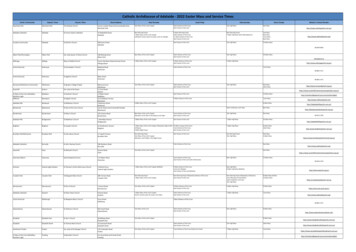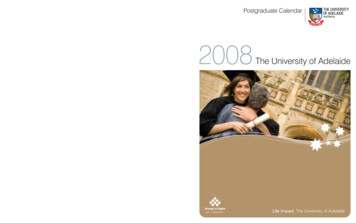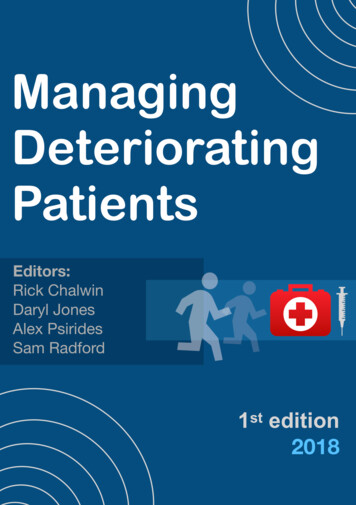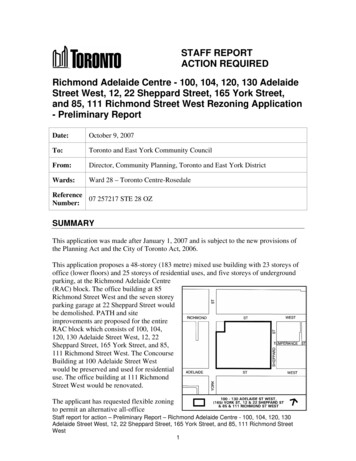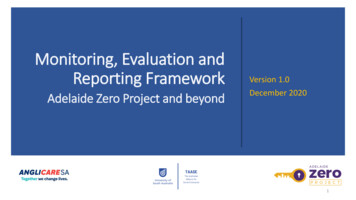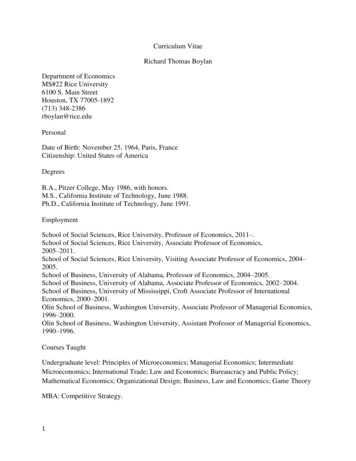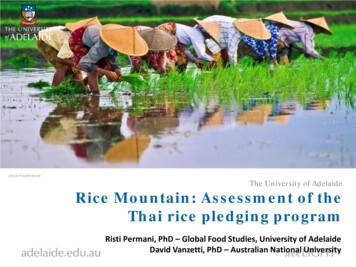
Transcription
The University of AdelaideRice Mountain: Assessment of theThai rice pledging programRisti Permani, PhD – Global Food Studies, University of AdelaideDavid Vanzetti, PhD – Australian National University
edging-caseUniversity of Adelaide2
BackgroundOverview of the rice sector in ThailandAnalysisConcluding remarksUniversity of Adelaide3
Background Rice production and consumption:– From 2001 to 2009, approximately 70 % of rice production wasconsumed in Thailand;– Annual rice consumption per capita is around 118 kg (about 30% oftotal food consumption).– Major export commodity in Thailand. The rice price-pledging scheme:– To win electoral support, the former Prime Minister YingluckShinawatra provided market price support to paddy rice producers.– Between 2004 and 2014, Thailand implemented 11 subsidy schemescovering 15 harvests. But the most significant was implemented byPrime Minister Shinawatra in 2011 when the price premium wasabout 50 per cent above the going market rate.– The Government also reduced exports and built up stocks in aneffort to push up world prices.– This scheme was discontinued in May 2014 when the Governmentwas dismissed.University of Adelaide4
Thailand’s Finance Ministry has estimated the total losses ataround 700 billion baht (around US 21,5 billion which morethan three quarters of these losses (i.e. 536 billion baht or 16,5 billion) occurred since 2011 (Bangkok Post 2015).– Many believe, however, that there is the lack of transparency in theprocess of obtaining this estimate.– Getting the right estimate is crucial given the civil suit broughtagainst the former PM.– In early 2015, the National Anti-Corruption Commission (NACC)formally asked the Finance Ministry to file a civil suit demandingcompensation from Ms Shinawatra for negligence in hergovernment’s rice pledging scheme.– The demanded compensation would depend on total losses resultingfrom the policy highlighting the importance of reviewing methods toget estimates of the policy’s welfare effects.University of Adelaide5
Objectives Despite exhaustive media coverage, to the authors’ knowledge,there has not been any empirical study demonstrating thewelfare effects of the Thai rice pledging scheme.– The most relevant study is by Warr (2014a). Whilst the studyprovides important insights into the impacts of (unilateral)elimination of trade barriers including to agricultural commodities,it assumes that the rice pledging policy effects on the rates ofprotection as ‘temporary’ (Warr 2014a). Therefore, the simulationresults do not specifically present the welfare effects of the ricepledging scheme. Given the above background, this study, therefore, aims atinvestigating the welfare effects of various Thai rice policyoptions including the pledging scheme and selling-offstrategies.– Using 2010 as the base year, in particular, it applies a dynamic,stochastic, ten-region, partial equilibrium model of world rice trade.University of Adelaide6
Thai rice area, production, exports and Area harvested (1000 ha)10,66711,00010,83710,920Milled production (kt)20,26220,46020,20020,460Exports 30010,40010,60010,875Ending stocks (kt)Domestic consumption (kt)Source: USDA (USDA 2015). ‘kt’ means kilo tonnes.University of Adelaide7
Thai rice production and domestic consumption (1960-2014)University of Adelaide8
Thailand stocks (% total production) (1960-2014)University of Adelaide9
The pledging scheme The rice price-pledging scheme:– The initial objective was to provide a loan at low interest rate forfarmers who needed cash in the early harvesting season so thatthe farmers can keep their products from selling at low price anddelay sales until prices rise later.– The Bank of Agriculture and Agricultural Cooperative (BAAC) tolend the farmer money equivalent to the predetermined value ofthe pledged rice.– The farmers receive the loan for their pledged rice at the netinterest cost of 3% per annum and are given 5 months to redeemtheir pledged rice. Otherwise the pledged rice goes to thegovernment.University of Adelaide10
Criticism The pledging scheme sparked debate over strategies toachieve food security programs particularly in the Asianregion.– A standard buffer stock scheme normally involves governmentspurchasing and stockpiling a commodity when prices are lowand selling it when prices are high.– The Thai policies seemed to have been aimed at raising worldprices by temporarily removing supply from the world market.The former PM Shinawatra was accused of attempting “tomanipulate the world’s rice market by buying up supplies”(Murdoch 2013).University of Adelaide11
Was Thailand ‘big enough’ to influence theglobal rice market? The world price of rice showed nosignificant increase between 2011 and2012.– – The price level in September 2011 was 616 per tonne but since then it hastrended downwards, and is currentlyaround 400.This could mean that the global ricemarket has been quite competitive whereeven a major exporter is not a pricemaker.Classifying rice into four categories,Mahanaseth and Tauer (2014) suggestedthat:– Thai rice price, 2003-2014For aggregated rice exports, Thailand doesnot have market power to influence exportprices in its four major export markets.Results indicate that Thailand has somemarket power in the glutinous rice exportmarkets to China and Indonesia.Source: IMF (IMF 2014)Thailand’s domestic pricing programs arenot heavily distorting world rice markets(John 2013).Other reasons?University of Adelaide12
Bad timing? The timing of Thailand being edgedout of its top exporter position forthe first time in three decades wassimultaneous with:––––Rice export share, 1960-2014India needing to unload stocksaccumulated during a four-year ban onnon-Basmati exports (Larson 2013).Indonesia also bought less rice fromThailand due to higher domestic output(Russell 2013).The Philippines’ commitment to importrice from Thailand was constrained bythe passing of the importation burdenonto the private sector.Thailand is also facing increasedcompetition with Vietnam (Lakkakulaet al. 2015). The private sector inPhilippines preferred to import ricefrom Vietnam due to its lower price(Manila Bulletin 2013).University of Adelaide13
Analysis: Policy scenariosBaselineUniversity of Adelaide 2010 dataScenario A Pledging scheme 3-year stock purchaseScenario B Pledging scheme 3-year stock purchase Stock sell-off in one yearScenario C Pledging scheme 3-year stock purchase Stock sell-off in three years (5000 kt in Years 4-6)Scenario D Pledging scheme 3-year stock purchase Stock sell-off in five years (3000 kt in Years 4-8)14
Welfare effectsNumber of yearssince the programlaunch123456789TOTALUniversity of lfare change (in billion)CDEPledging scheme Pledging schemePledging3-year stock scheme purchase 3-year stock3-year stockStock sell-off in onepurchase purchase yearStock sell-off inStock sell-off(15000 kt in Year 4)three yearsin five years(5000 kt in Years(3000 kt in4-6)Years 015
By assuming that the government sets the pledged price50 per cent above the market rice and purchases 5,000tonnes per annum, results from this study suggest thatthe program would cost the government about 11.8billion in the first three years of programimplementation (i.e. 2010-2012) and 15 billion in itsfirst four years of implementation (i.e. 2010-2013).– Quite close to the ones reported by: the World Bank (2012): a loss of 1.2 per cent of GDP for the2012/2013 Program (or based on the Thai GDP at 2013 it equals 11billion); Recently, the Bank’s 2014 East Asia Economic Update quoted anestimate by Thailand’s Ministry of Finance suggesting a loss of 3.8per cent of GDP (or based on the Thai GDP at 2014 it equals 14.7billion) (The World Bank 2014).University of Adelaide16
Dealing with the rice mountain Selling within one year is the best approach, resulting inminimum welfare losses.– Mainly explained by significant storage costs.– Selling off Government stocks over one, three and five years resultsin estimated sector-wide welfare losses of 8 billion, 11.7 billionand 14 billion respectively over a five year period. Out of 18 million tonnes of rice stocks that the Thaigovernment accumulated from the pledging scheme, only 10per cent are of standard quality; about 70 per cent are belowstandard and about 20 per cent are unfit for humanconsumption (Oryza 2014). The government loss would beeven greater for the three-year and five-year scenarios ifspoilage were considered.– Our estimate does not take account of spoilage over time.University of Adelaide17
Recent development Pressure on world rice pricecontinues– The Thai military government isplanning to sell 11 milliontonnes of rice in 2015.– But as of June 15, Thailand hadonly shipped 3.9 million tonnesof rice this year. Protectionist trade policiesremain in place:– On-farm pledging scheme(albeit at lower prices than theone under Yingluck); theincome support measure; theoff-farm employment assistantprogram, a rice insuranceprogram, the interest subsidyprogram.University of Adelaide18
Food for thoughts Substantial losses areevident. Concerns about how Asiancountries collectivelyachieve regional foodsecurity.– At what level would wedefine food security?– What frameworks would‘work’ when there is a shockto the food system?– Who are the losers andwinners?– How can we define goodfood policy?University of Adelaide Do the so-called protectionistpolicies really protectsmallholder producers? At what cost? Is there any alternativepolicy/program to thecurrent ones?19
Thank you. Email: risti.permani@adelaide.edu.au Website: http://www.adelaide.edu.au/global-food/University of Adelaide20
The University of Adelaide Risti Permani, PhD - Global Food Studies, University of Adelaide . David Vanzetti, PhD - Australian National University . ten-region, partial equilibrium model of world rice trade. University of Adelaide 6 . Thai rice area, production, exports and stocks. 2010/11. 2011/12: 2012/13: 2013/14 (i) (ii) (iii) (iv .




